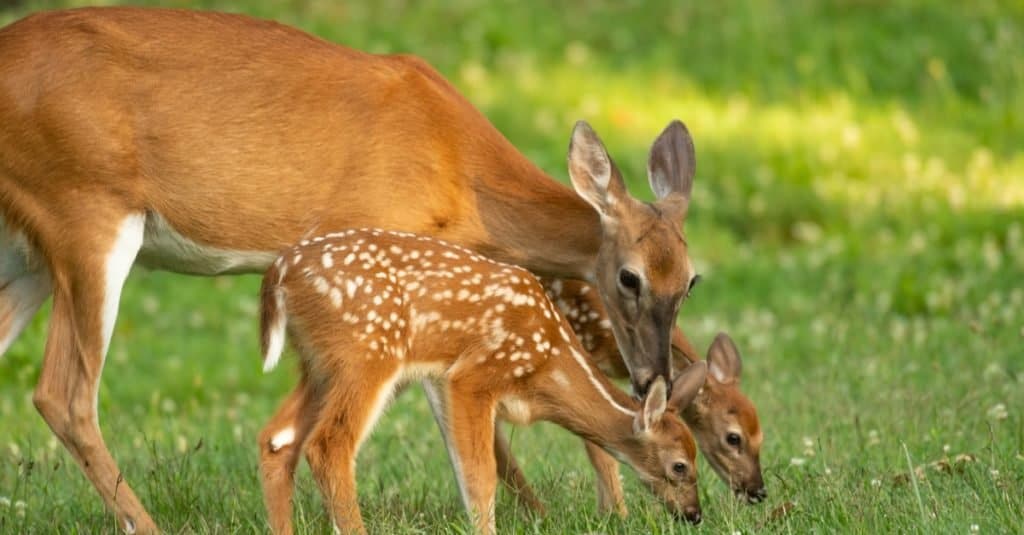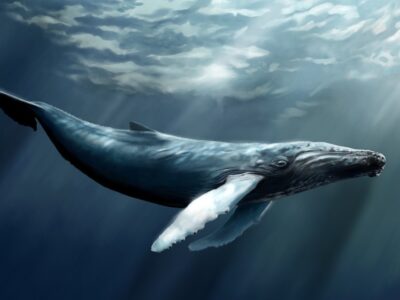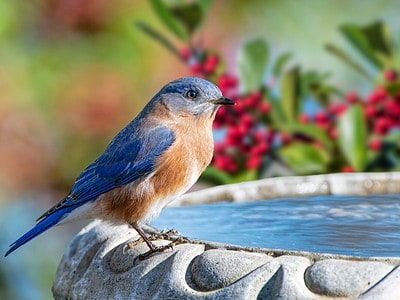Whitetail Deer
Odocoileus virginianus
Although deer are herbivores, they will sometimes eat mice and birds when they can catch them.
Advertisement
Whitetail Deer Scientific Classification
- Kingdom
- Animalia
- Phylum
- Chordata
- Class
- Mammalia
- Order
- Artiodactyla
- Family
- Cervidae
- Genus
- Odocoileus
- Scientific Name
- Odocoileus virginianus
Read our Complete Guide to Classification of Animals.
Whitetail Deer Conservation Status
Whitetail Deer Facts
- Prey
- Grasses, leaves, and other plant matter
- Main Prey
- Grasses
- Name Of Young
- Fawn
- Group Behavior
- Solitary
- Family units
- Fun Fact
- Although deer are herbivores, they will sometimes eat mice and birds when they can catch them.
- Estimated Population Size
- 10 million
- Biggest Threat
- Humans--hunting and loss of habitat
- Most Distinctive Feature
- Flashes the white underside of its tail when frightened.
- Distinctive Feature
- Fawns have white spots.
- Other Name(s)
- Virginia deer
- Gestation Period
- 201 days
- Temperament
- Non-aggressive
- Age Of Independence
- 2-3 months
- Litter Size
- 1-3
- Habitat
- Forests, swamps, savannahs
- Predators
- Wolves, lynx, cougars
- Diet
- Herbivore
- Average Litter Size
- 1-3
- Lifestyle
- Crepuscular
- Favorite Food
- Grasses
- Common Name
- White-tailed deer; Virginia deer
- Special Features
- Reddish-brown to greyish-brown coats
- Number Of Species
- 26
- Location
- North and South America
Whitetail Deer Physical Characteristics
- Color
- Brown
- Red
- White
- Dark Grey
- Grey-Brown
- Skin Type
- Fur
- Top Speed
- 30 mph
- Lifespan
- 6-14 years
- Weight
- 150-300 pounds
- Height
- 24-48 inches at the shoulder
- Length
- 72-96 inches long
- Age of Sexual Maturity
- 1- 1.5 years
- Age of Weaning
- 3-4 months
- Venomous
- No
- Aggression
- Low
View all of the Whitetail Deer images!
Interesting Fact
“Deer can see blue and yellow, but they cannot distinguish red and orange.”
White-Tailed Deer Summary
White-tailed deer are a widespread species found in the Americas. When frightened, they run away and flash the white underside of their tails, which is the origin of their common name. White-tailed deer have been an important source of meat, leather, and antlers as trophies and materials for handcrafted items from ancient times to the present day. Despite heavy hunting, this species remains plentiful throughout most of its habitat.
White-Tailed Deer Facts
- Texas has the largest white-tailed deer population in the U.S. with 5.3 million specimens.
- When startled, these deer flash the white fur on the underside of their tails. This is how they got their common name.
- Although they are herbivores, they will also occasionally eat mice and birds.
- Thanks to their multi-chambered stomachs, they can eat foods humans cannot, including toxic mushrooms and poison ivy.
- Deer can see in color, but they see best in blues and greens. They cannot see reds and oranges.
White-Tailed Deer Scientific Name
The scientific name of the white-tailed deer is Odocoileus virginianus, from Latin words meaning “hollow-tooth” and Virginia, an American state where they are plentiful. One of the common names of this deer is the Virginia deer. White-tailed deer are part of the Mammalia class and the Cervidae family.
There are 26 subspecies of the white-tailed deer, with 17 of these living in North America.
White-Tailed Deer Appearance
This is a medium-sized deer species, ranging from 72 to 96 inches long and 24-48 inches tall at the shoulder. Those in colder environments grow larger than those in warmer climates. Males are called bucks and can weigh anywhere from 150-300 pounds. Females, called hinds or does, can weigh 88-200 pounds.
Bucks grow antlers each spring and shed them in winter after the mating season. The size and branching of a buck’s antlers are influenced by his age, nutrition, and genetics.
Whitetail deer coats are reddish-brown in the spring and summer, turning to greyish brown in the fall and winter. They get their common name from the white underside of their tails, which they flash when under threat.
Interestingly, there is a population of entirely white (not albino) white-tailed deer in New York state. They are concentrated in Deer Haven Park at the Seneca Army Depot in Romulus, New York.

Whitetail deer coats are reddish-brown in the spring and summer, turning greyish brown in the fall and winter.
©Tony Campbell/Shutterstock.com
White-Tailed Deer Behavior
White-tailed deer are crepuscular, meaning they are most active around dawn and dusk. They have pupils that are slit horizontally, giving them good night vision. Compared to humans, they can process visual images more quickly and see motion in low light more easily. This is also a reason deer freeze in the road when they look into car headlights. Their pupils are dilated at night, so they are blinded by bright light and freeze until their eyes adjust to the light.
They can see in color in shades of blue and yellow but cannot distinguish reds and oranges very well. This is why hunters can wear bright orange as a safety color, without alerting deer to their presence.
White-tailed deer communicate with sounds and body language. Under threat, they will stomp, snort, and raise their tails to show the white fur underneath as a warning to other deer. They also mark their territory with urine and scent glands. A deer’s territory is usually less than one square mile.
Does stay together in family groups with their fawns. Males form their own groups with other males, but separate as individuals during mating season.
White-Tailed Deer Habitat
White-tailed deer are indigenous to North America, Central America, and South America, as far south as Peru, Bolivia, and northern Brazil. This species is the most widely distributed ungulate (a classification of large-hooved mammals) in the Americas.
They can adapt to many different habitats, including open prairies, savannahs, regions of arid sagebrush, and forests of various kinds, including tropical rainforests.
In North America, they are most plentiful east of the Rocky Mountains, while black-tailed or mule deer are found west of these mountains. Texas is the U.S. state with the largest population of this species—an estimated 5.3 million.
White-tailed deer have been successfully introduced to several Caribbean Islands, European countries, and New Zealand. In 1935, four specimens were introduced into Finland; by 2020 these had increased to 109,000.
White-Tailed Deer Diet
White-tailed deer are herbivores that eat an enormous amount. In one year, a single adult can consume 2,000 pounds of vegetable matter, about the weight of a small car.
Deer like to forage around dawn and dusk. They like legumes, grasses, leaves, cacti, acorns, and fruit. Because of their multi-chambered stomachs, they are able to digest some foods that are inedible for humans, including toxic mushrooms and poison ivy. In farming areas, they eat hay, clover, corn, and other crops and in suburbs they browse on grass, garden plants, flowers, and shrubbery. Some homeowners intentionally plant deer-resistant species for this reason.
Although this species is herbivorous, at times of necessity they have some unusual eating habits. If they lack minerals such as calcium, they will chew on the bones of dead animals. They will also feed on birds and mice when they can catch them and are hungry enough.
Feeding wild deer is not a good idea as it can upset the balance of their digestion, make them less afraid of humans and more vulnerable to hunters and car accidents, and increase their population leading to starvation and disease.
White-Tailed Deer Predators, Threats, and Conservation Status
The wild predators of the white-tailed deer include wolves, pumas, American alligators, bears, coyotes, lynx, bobcats, wolverines, and feral dogs. A more recent threat has emerged in the Everglades of south Florida, where a growing population of invasive Burmese pythons can eat adult deer when full-grown. Fawns can fall prey to predatory birds, including eagles.
As with many species, white-tailed deer are most threatened by humans. Historically they have been an important source of nutrition, leather, and materials for traditional handicrafts. Today, the main threat to them from humans is loss of habitat, sport hunting, and collisions with vehicles on the road. Farmers and homeowners often consider them a nuisance because of the damage they do to crops and landscaping.
Despite these threats, white-tailed deer remain plentiful, with a worldwide population of over 10 million. Their population is stable, and their conservation status is “Least Concern.” However, two subspecies of the white-tailed deer, the Florida key deer and Colombian white-tailed deer, are considered “endangered.
White-Tailed Deer Reproduction, Babies, and Lifespan
The breeding season for white-tailed deer is called the rut. It happens in October or November. Bucks spend most of the year in same-sex groups, but during the rut they become solitary and use their antlers to fight other males for their choice of does. Each buck tries to mate with as many females as possible during mating season.
After mating, gestation takes 201 days. A doe gives birth to between one and three fawns weighing 6-8 pounds at birth. These babies will grow to 60-70 pounds by their first winter. They have reddish fur with a white underbelly and white spots on their backs for camouflage. These fade away with adulthood. Does hide their fawns in the undergrowth and nurse them four to five times a day. They are weaned from their mother’s milk after two to three months.
Young bucks leave their mothers earlier than their sisters. Bucks mature at about 18 months, while young does mature sexually at six months but stay with their mothers until they are two years old.
The life expectancy of a white-tailed deer ranges from six to 14 years. In captivity, they can live as long as 20 years.
White-Tailed Deer Population
The global population of white-tailed deer is estimated at over 10 million and is stable. In some areas, they hybridize with local species or displace them from their habitat.
Similar Animals to the White-Tailed Deer
- Elk – Like deer, elk are part of the Cervidae family, but they grow much larger, up to 1,300 pounds. They prefer mountainous forests and travel in large herds.
- Moose – These members of the deer family have large, wide, flat antlers and a large muzzle. They are the largest deer species in the world, weighing up to 1,500 pounds.
- Reindeer – Also known as caribou, these deer range further north than other deer species. They can be found in sub-Arctic boreal forests and tundra regions. They do not weigh as much as elk, but they have larger antlers than elk relative to their body size.
Related Animals
View all 108 animals that start with WWhitetail Deer FAQs (Frequently Asked Questions)
Do white-tailed deer make good pets?
No. It is illegal in most cases to own a deer as a pet. When young, they are intelligent, affectionate, and can be trained. However, as adults they can be unmanageable and can become aggressive, especially during mating season.
Are white-tailed deer aggressive?
Usually white-tailed deer are not aggressive. If you encounter one, they are most likely to run away. However, during mating season or when fawns are born in the spring, white-tails can become protective and territorial. Males can attack with their sharp antlers, and either sex may use their sharp hooves to drive away a threat.
What does deer meat taste like?
Deer meat, or venison, is often described as “rich” and “earthy.” It is similar to beef, but less juicy. It can be substituted for beef in steaks, hamburger patties, stews, jerky, and other popular foods.
Why do deer freeze in the road when they see headlights?
The vision of a deer is optimized for low light conditions. Their eyes are dilated to take in as much light as possible. When they look into a bright light, they freeze while their eyes adjust to the light.
Thank you for reading! Have some feedback for us? Contact the AZ Animals editorial team.
Sources
- ThoughtCo. / Published June 2, 2019 / Accessed November 9, 2022
- Wikipedia.org / Published November 4, 2022 / Accessed November 9, 2022
- AnimalWised / Published January 8, 2017 / Accessed November 9, 2022
- SteaksAndGame.com / Accessed November 9, 2022
- New Hampshire Charitable Foundation / Accessed November 9, 2022
- The New York Times / Accessed November 9, 2022


















